A Rare Catch

A Rare Catch
Flying into a North Woods pond for the chance to see—and catch—Maine’s most elusive fish
by Darrell Hartman
Photography by Aimee Bartee
Issue: September 2020
Igor Sikorsky gives me a choice: Grateful Dead or Jimmy Buffett. This is an easy one, and a few ticks later the sound of Jerry Garcia’s voice over noodling guitars comes piping into my headphones as my host’s Cessna four-seater rips up the middle of Munsungan Lake and lofts high over a glorious rollout of the North Maine Woods.
Igor’s wife, Karen, tries to get comfortable in the rear as morning gusts knock the plane to and fro. Their lodge, Bradford Camps, recedes from view behind us. I catch a glimpse of the logging road, now a beige thread through the woods, that I traveled yesterday from the timber town of Ashland, a two-hour drive away. To our right, the lumpy Appalachians trail away like an unfinished thought.
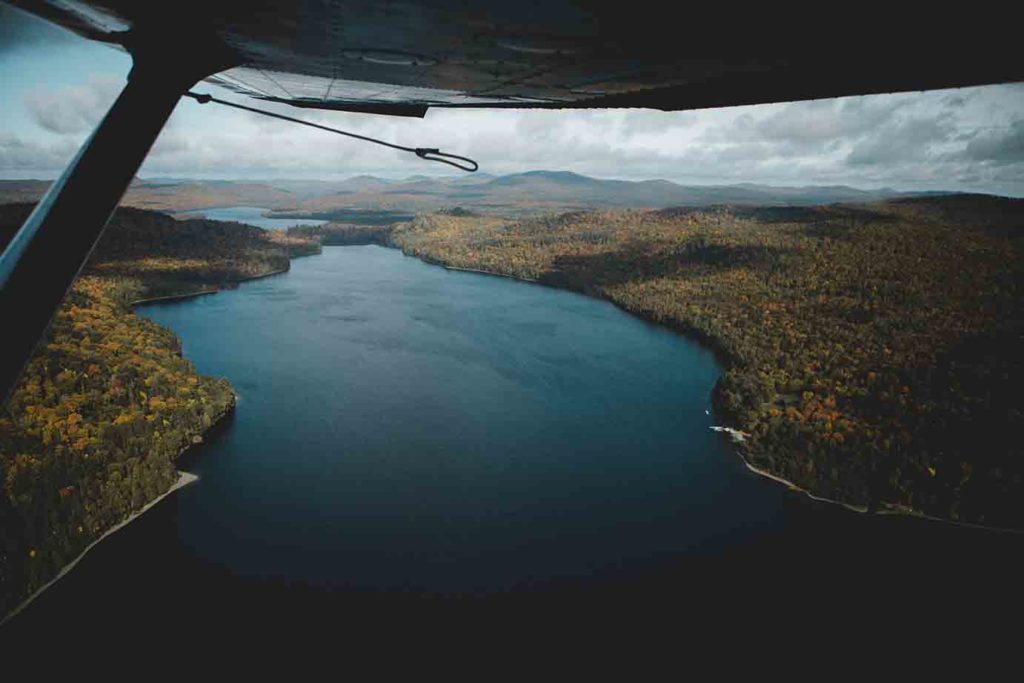
Igor Sikorsky’s Cessna float plane rises above Munsungan Lake, home of Bradford Camps. It’s a two-hour drive along commercial logging roads from Ashland, the nearest town, and there is no cell service along the way. Igor and his wife, Karen, advise guests to fly in from Shin Pond, Millinocket, or Bangor. Those arriving by car should bring a printout of detailed directions and be prepared to fix a flat tire.
Igor banks left, and a few minutes later, headphones off, we are unpacking fishing gear at the lone dock on Big Reed Pond. Igor and Karen grab a canoe they’ve stashed nearby, and we paddle out to join the rest of our party. It includes Josh Collins, a thick-bearded Bradford Camps guide, and Chase and Aimee Bartee, the young couple responsible for documenting this remote fishing trip on film and video.
“See anything yet?” we call out. Collins mutters that he’s caught one without meaning to. Chase announces he’s just released a 14-incher. Sugar magnolia! This is good news. They aren’t talking brook trout, lake trout, landlocked salmon, or any of those other run-of-the-mill species. Our whole trip is about finding a much rarer and more elusive native of Maine’s wild waters, a leading candidate for the Northeast’s most enigmatic fish. Here it is, barely 10 a.m., and we’ve already landed two of them.
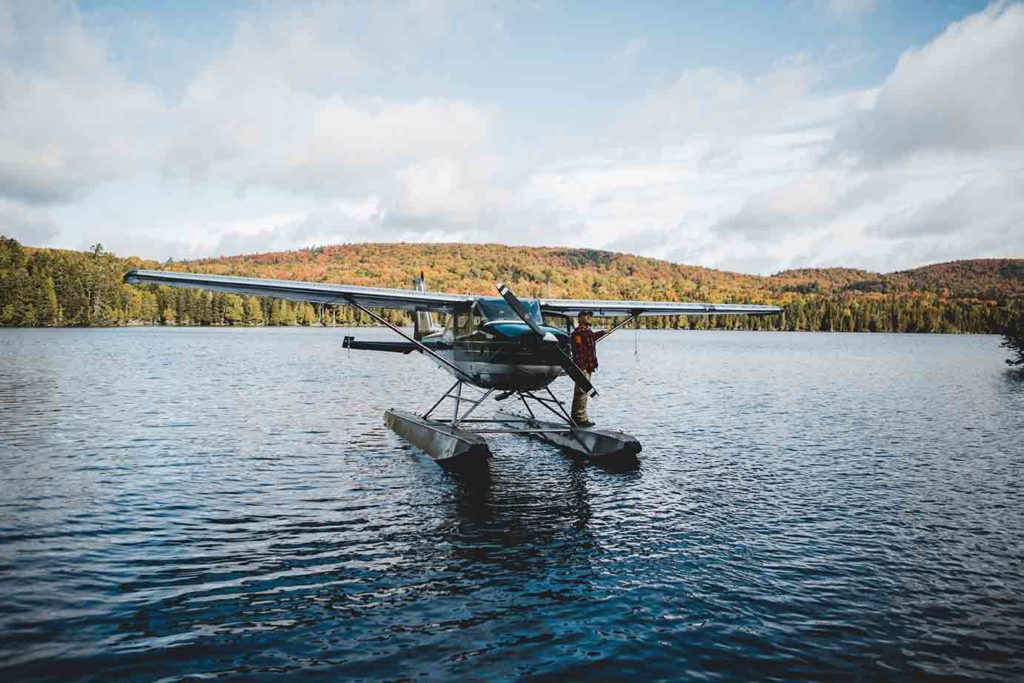
Big Reed Pond was the site of an ambitious state-led “reclamation” aimed at restoring native populations of bluebacks and brook trout that had been decimated by invasive fish. Bradford Camps owner Igor Sikorsky, on his float plane, estimates that he has donated around 100 flights to the cause, which appear to have been worth it. “We’re 25 years into owning this place, and the fishing’s finally coming back,” he says.
Blueback trout are holdovers from the last Ice Age, silvery deposits left buried in the landscape by retreating glaciers. They dwell only in Maine’s deepest, coldest waters, where they rarely venture near the surface. Bluebacks are known to exist in a mere dozen of the state’s 6,000 lakes and ponds, and most of these waters require a plane or a sturdy pair of hiking boots to get to. Catching one—on a flyrod, no less—is no casual affair. And yet more people than ever seem eager to try it, as concern over the fish’s future and an outpouring of conservation efforts—the most ambitious of them spearheaded by the Maine Department of Inland Fisheries and Wildlife (MDIFW) here on Big Reed Pond—have put this shadowy species in the limelight as never before.
Native bluebacks once populated a handful of northeastern states; now, though, Maine is the only state in the lower 48 that has them. It was in Maine, too, that the fish first attracted notice. In the Rangeley Lakes, bluebacks were a dietary staple of the monster brook trout that helped establish the region as a prime sporting destination in the second half of the nineteenth century. “That population is partly responsible for Maine being called Vacationland,” notes Michael Kinnison, a University of Maine biologist who has studied the species for 20 years.
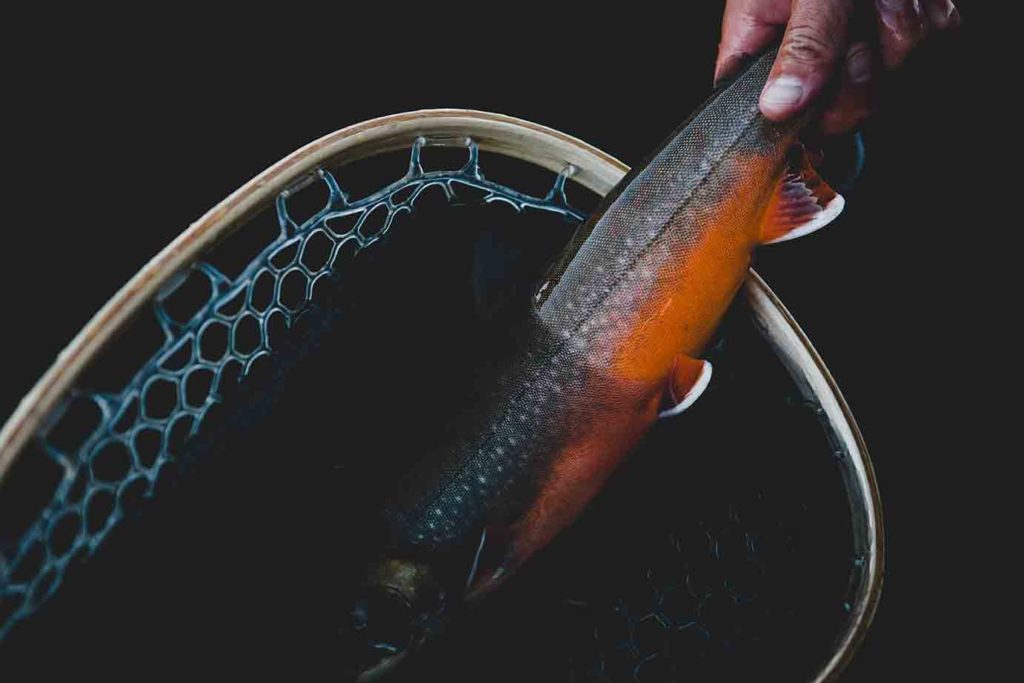
Bluebacks (Salvelinus alpinus oquassa) are found in only a dozen lakes and ponds in Maine and no longer exist anywhere else in the contiguous United States. Long considered trout, they have more recently been reclassified as a regional subspecies of Arctic char. They can be hard to distinguish from brook trout, with the most reliable giveaway being the blueback’s forked tail.
Those bluebacks grew to the length of a hand, at most. (The biggest ever recorded in Maine, a five-pounder caught in 2008, measured more than 25 inches.) Although they were too small and reclusive to catch on as game fish, bluebacks were netted for eating by Rangeley’s nineteenth-century settlers in the fall, when the fish poured into brooks and streams for spawning. By the 1870s they were also being harvested for the marketplace. Meanwhile, as eager tourists reduced Rangeley’s stock of trophy-sized brook trout, a local fishing club introduced non-native landlocked salmon, a second blueback predator, in hopes of keeping the sportfishing business humming. The results seem woefully predictable in hindsight: several years into the twentieth century, Rangeley’s bluebacks were no more.
New Hampshire’s Sunapee trout population disappeared from its home lake (another popular nineteenth-century vacation spot) around this time, too, a victim of similar circumstances. It was later shown to be genetically identical to the blueback, which has been reclassified in recent years as a regional subspecies of Arctic char—a smaller, landlocked version of those salmon-like fish you can find on ice at Whole Foods. The reclassification was hardly groundbreaking—it had been discussed for decades, and the eastern brook trout is also technically a char—but it does bolster the myth of the blueback as a sort of piscatorial lost tribe, confined to a handful of backwoods colonies while its bigger, bolder sea-run cousins make migratory sweeps through the globe’s polar regions.
Gary Corson, who’s now retired, started guiding at Big Reed Pond in 1990. The char there grew considerably larger than their long-gone Rangeley cousins, and the 90-acre pond had a reputation as one of the nicest spots in Maine to hook one, whether you flew in for that reason or simply decided to switch tactics after catching your limit of brook trout. Corson never imagined that by 2003 the fishing at Big Reed would be so bad that he’d stop guiding there. “To go from a Class A to a Class F fishery in that short a time—I never would have believed it to be possible, unless it was an oil spill or some catastrophe like that,” he says.

Studying the guest logs at Big Reed Pond, where Bradford Camps rents out overnight cabins.
In this case, the catastrophe was rainbow smelt. Corson was the first to spot them, a year or two after he started guiding at Big Reed. Like most everyone else, he figures that a negligent bait-fisherman was the source of the unwelcome species. The smelt competed for resources with the younger char, then started preying on them. The char population nose-dived.
MDIFW intervened in 2007, persuading the Nature Conservancy (which owns the 5,000-acre reserve surrounding the pond) to support the “reclamation” of Big Reed. Frank Frost, the state biologist in charge of the project, planned to remove a brood stock of 30 char from the pond before pumping in a plant-derived fish poison to eradicate the smelt. He and his colleagues tried trout nets, gill nets, commercial smelt nets, Norwegian-made char traps, lures, and worms—and not just in the short-underwear months. After four years of “inten-sively trying to capture fish,” Frost recalls, he and his team had secured a grand total of 14 char. “That’s how dire the situation was.”
At the time it was undertaken, the Big Reed intervention was the largest of its type in state history. The state restocked the pond with the native yearlings in 2011 and reopened it as fly-fishing-only water, which by law also means no trolling. It’s illegal, moreover, to keep a char from Big Reed. Char numbers are back to what they were before the smelt invasion, and, for a moment at least, the pond—located in the largest contiguous old-growth forest in the Northeast—is a purist’s dream.
“Big Reed is doing extremely well,” says Frost. Post-interven-tion char are spawning successfully. He thinks the bluebacks outnumber the brook trout, which bodes well for their emer-gence as a covetable game fish at this pond and others. “It’s tough fishing, but people are being successful. It’s really the fish of a lifetime if you catch one.”
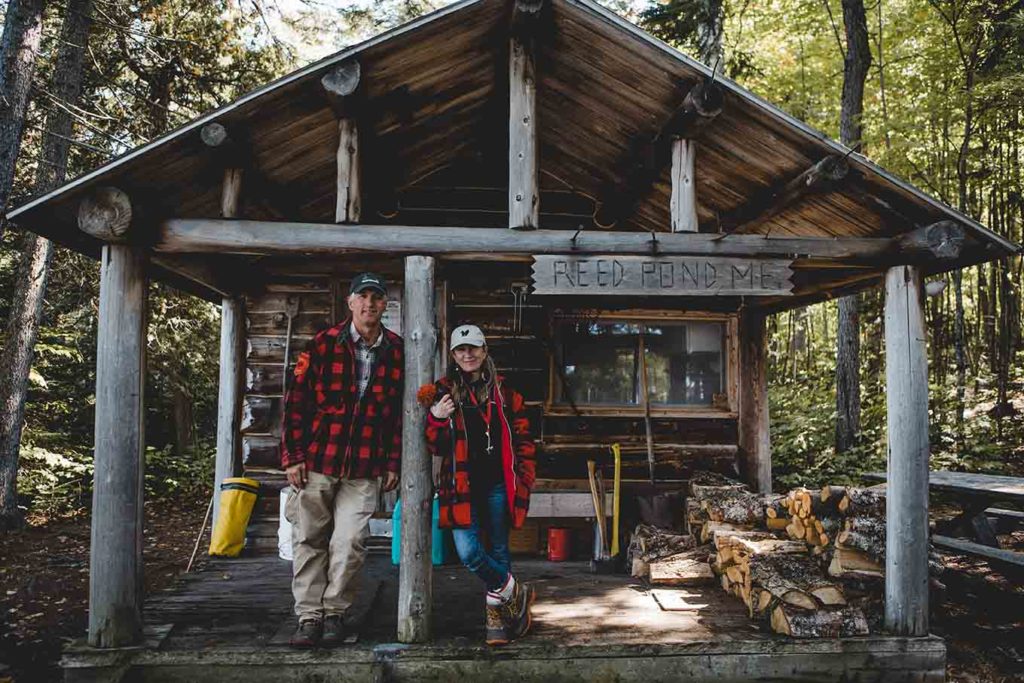
The Sikorskys at one of the guest cabins they maintain at Big Reed Pond, which is part of a 5,000-acre old-growth forest preserve owned by the Nature Conservancy.

Boiling water for coffee. 
Waiting for a strike at Big Reed Pond, which is fly-fishing only, with no trolling allowed.
Naturally, the action screeches to a halt once I get out on the water. I spend the first hour or so untangling, as I struggle to adapt from my usual floating line to the heavier full-sink rig that’s basically obligatory for bluebacks. I cast 40 or 50 feet of wet line, count to 30 as it sinks to the cold depths the fish swim in, then strip in line, hoping for a char to take the fly as it rises up through the water column. The other four people with lines in the water do the same. Three straight hours of this produces nothing.
We paddle ashore at lunchtime and eat sandwiches outside a pair of lakeside cabins that the Sikorskys lease from the Nature Conservancy. I browse through old logbooks full of rave reviews of the location and polite no-comments about the angling. Igor expects that to change. “We’re 25 years into owning Bradford Camps, and the fishing at Reed Pond is finally coming back,” he says, stoking a small campfire. The Sikorskys played no small role in the reclamation, lodging workers and helping with other tasks, including to drag a 500-pound jon boat a mile through the woods. Igor estimates that the 100 or so flights he donated to the project cost him $25,000.
Back out on Big Reed after lunch, the wind has slackened and the clouds have scattered. The sun turns the south bay into a blinding sheet of hot metal. The day’s transformation into a blue-sky beauty doesn’t change our luck, but it does make it easier to appreciate the old-growth conifers along the shore, which seem to hold a line between the complacent pond and the riot of fall colors closing in on it.

Given how deep bluebacks live, a sinking fly line vastly improves the likelihood of hooking one; some experience with a fly rod is recommended.
Just as the light gets golden, Chase is onto a blueback. It doesn’t leap or wag its head—it just puts a serious crook in his rod and dives for the bottom. Chase gets that hard fighter in, though, and when we paddle up alongside for a look, I can hardly believe that Big Reed’s inky depths have produced colors so staggering. The fish is a fiery yellow-orange that fades to spruce-green on its back. It puts the foliage to shame. We have barely celebrated its release when Aimee, too, has one on, a female whose spawning colors—bluer back, tangerine belly—are only slightly less brilliant.
The Sikorskys and I have thrown angling etiquette to the wind at this point. We squat on the Bartees’ honey hole and tie on the same patterns they’re using. Our labors produce nothing for us, and a third char for Chase. The Sikorskys and I have tallied nothing by day’s end, not even an incidental brookie. “That’s fishing,” as they say. For me, the strikeout only serves to enlarge the myth of the elusive blueback.
Of the four existing subspecies of Arctic char, Maine’s—which is also found in Quebec and New Brunswick—is the most limited in its geographic range. But the appearance and traits of Salvelinus alpinus oquassa show remarkable variability from lake to lake. They’ll feed primarily on fish in one pond, and on plankton and snails in another one nearby. They don’t rise to dry flies, the story goes—except at Wadleigh Pond, in the vicinity of Millinocket.
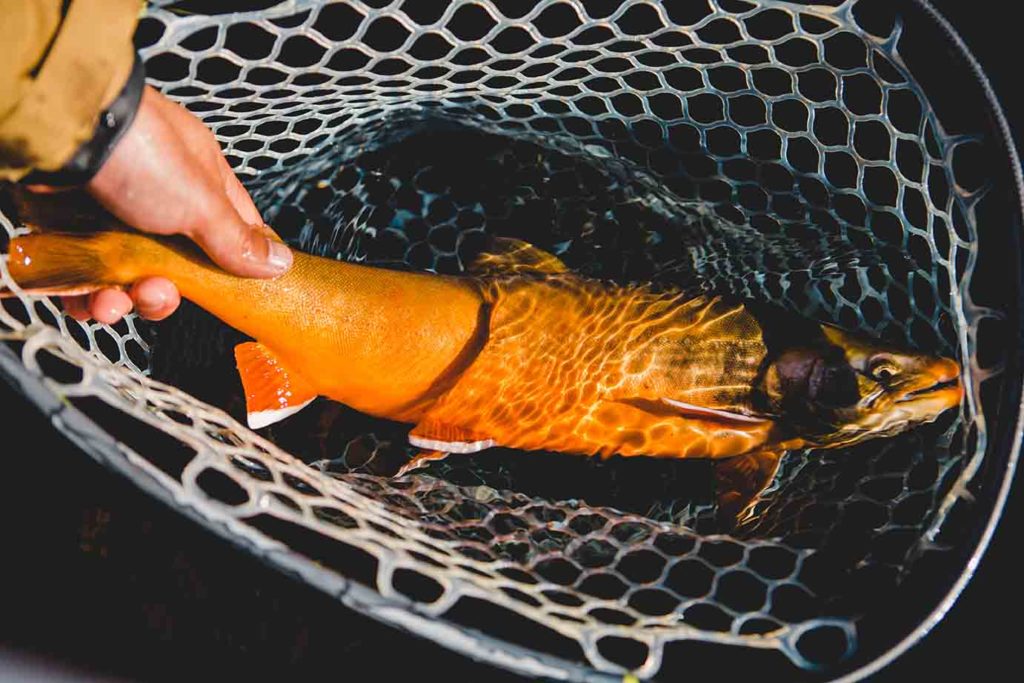
“It’s tough fishing, but it’s really the fish of a lifetime if you get one,” says Frank Frost, the Maine Department of Inland Fisheries and Wildlife biologist who led species-restoration efforts at Big Reed Pond. Bluebacks are most likely to bite in June, but only late-season anglers will see the fish in their brilliant spawning colors.
“It really is a hallmark of the diversity that occurs within species,” Kinnison explains. This extends to color and pattern, too, and is one reason it took experts so long to figure out that Sunapees and bluebacks—and golden trout and silver trout and white trout and red trout, as they’re still called in Quebec—were all the same fish. I can’t believe no one ever thought to call it orange trout, even if those fabulous colors are only seasonal.
Not everyone is ready to classify Big Reed Pond a success. “It looks good, but it we need to wait a few more years before we claim victory,” argues Bob Mallard, Maine-based execu-tive director of the Native Fish Coalition. He worries about the resilience of Big Reed’s limited gene pool and the state’s historical eagerness to roll back restrictions (such as bans on trolling, harvesting, and use of live bait) that help vulnerable populations to gain a foothold.
“Given the situation today, the number of secure char populations is probably the bigger question,” says Kinnison, who has been developing a method of sampling for char DNA without capturing the fish. Conservationists worry that the next local extirpation—which would be the first since Rangeley a century ago—is around the corner. In northwest Maine, for example, a combination of nonindigenous smelt and lake trout has been decimating Bald Mountain Pond’s bluebacks. (Ominously, the latter are thought to have hybridized bluebacks into extinction in Vermont and New Hampshire.)
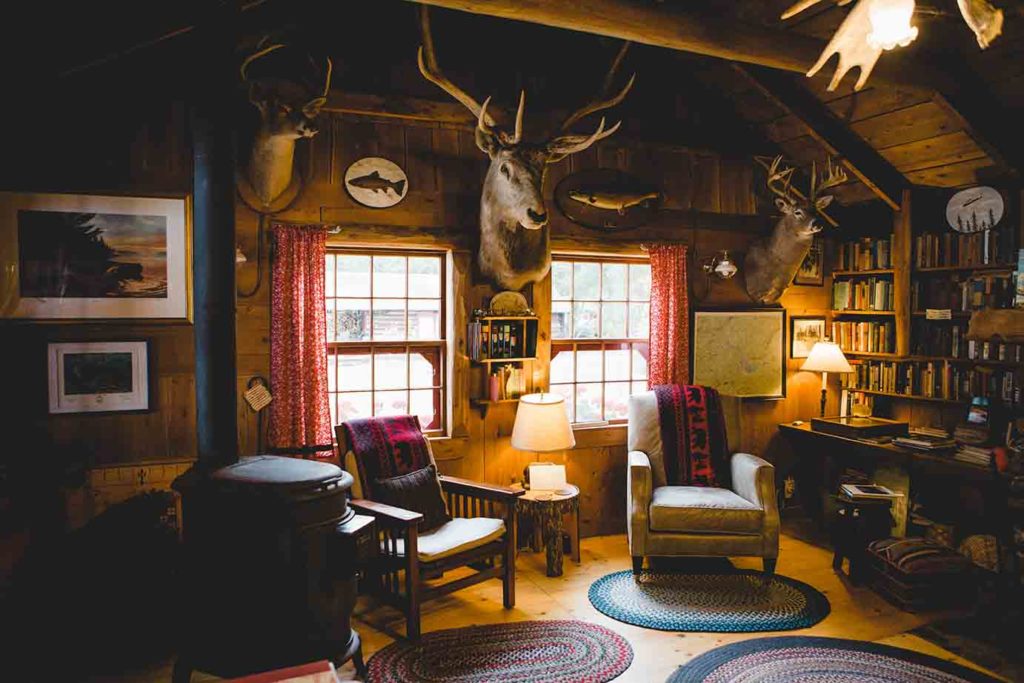
Unlike the guest cabins, the main building at Bradford Camps runs on electricity. Ownership has changed hands only four times over the 130 or so years it has been in business, most recently in 1996.
Mallard and Corson both posit that the most secure popu-lation is in Wassataquoik Lake, which benefits from Baxter State Park restrictions—no fly-ins, no live bait—and is a six-mile hike from the nearest road. The threats at Black Pond and Gardner Pond, both in Aroostook County, also seem less imminent than elsewhere. By the usual logic of native trout and salmon conservation, accessibility and vulnerability go hand-in-hand. Nor can the professionals in hazmat suits save the day next time: Frost told me that Big Reed and Wadleigh Pond, which the state reclaimed in 2013, are the only two char waters small and shallow enough for full-scale intervention.
We fly back to Bradford Camps as the last smears of sunset color—a rosy inversion of the char’s dark green and orange—fade from the horizon. Dinner is breaded chicken thighs with fresh-baked popovers, and dessert is homemade blueberry pie.
Igor and I talk about another hallmark of the Maine outdoors whose future is uncertain: the classic sporting camp. Although Bradford Camps dates to the late nineteenth century, the condition of its spruce-log cabins—containing woodstoves, gas lamps, sparse furniture—shows that it has been more lovingly cared for than most. (The lodge did not welcome guests this season, due to coronavirus concerns, but will reopen in 2021.) When the Sikorskys, both out-of-staters, bought the lodge in 1996, it changed ownership for only the fourth time in a hundred years.
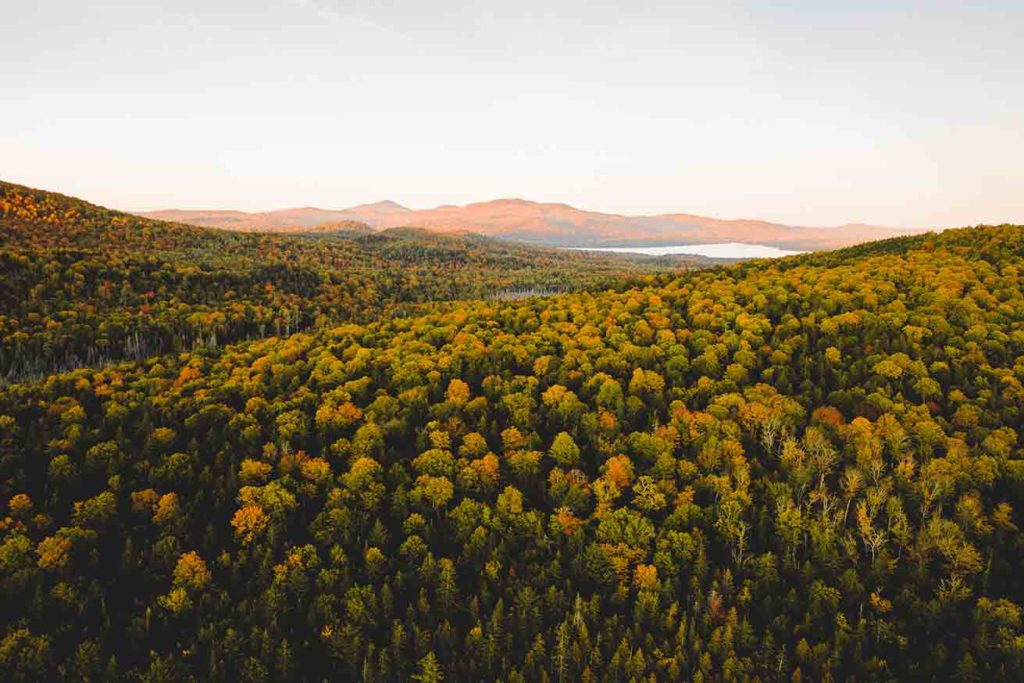
The return to Munsungan Lake after a day of fishing at Big Reed Pond.
In a way, their stewardship of Big Reed and its comeback char has just begun. “I don’t want it to get loved to death,” Igor emphasizes. Although I know it’s gnawing at him that he didn’t put me onto a fish, I assure him that I’m happy just to have seen one. Correction: four. Trust me, I can sugarcoat a skunking as well as anyone. But with this particular fish, at the end of this particular day, no more than a dusting of sweetener is called for, and I know that most fly-fishers who choose to go in pursuit of Maine char would at some point find solace in Igor’s philosophical take on our outing. “Knowing you’re fishing over blueback trout and not catching them is, in some senses, just as valuable.”

